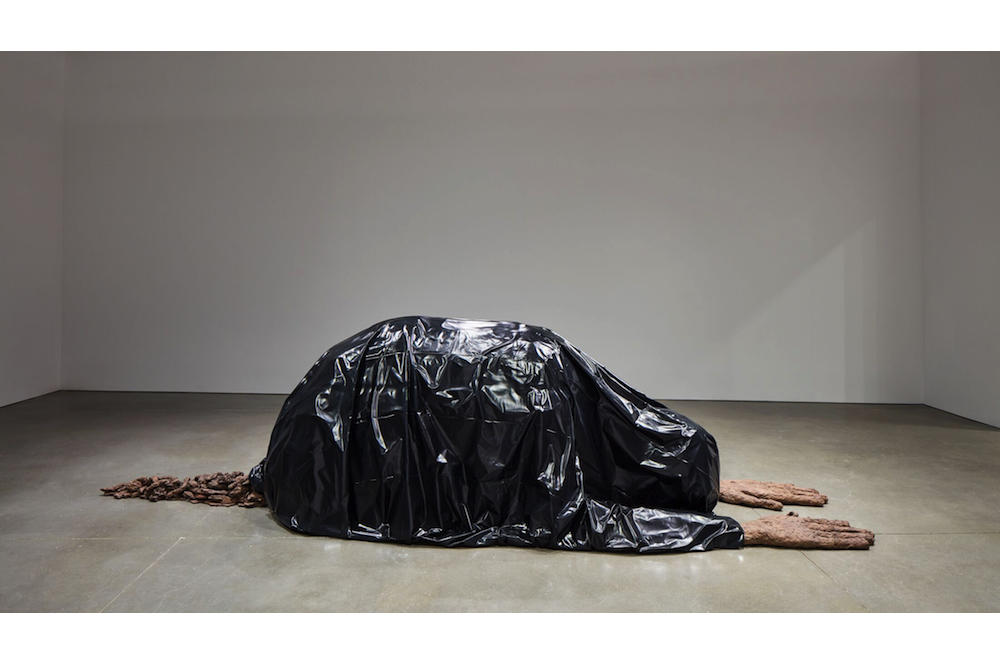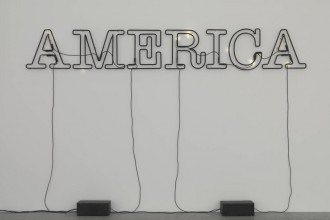The works of Huma Bhabha affect a strange pareidolia: they lure, and then repel, dissipating the familiarity they promise. The Karachi-born artist mines the depths of classical Mediterranean, Indian, and Greek antiquity, as well as Western Modernism, science fiction, and postcolonial theory, to produce works that edge the unheimlich, the uncanny. Teetering between a sensuous attention to material surfaces and a relentless probing of the viewer’s psyche, Bhabha’s work capitalizes on the draw of the unfamiliar. Little in the artist’s oeuvre opens itself upon an initial encounter, a productive uncertainty that permits her to encircle the thorny politics of representing the residue of colonialism and imperialism.
Titled after the 1988 John Carpenter film of the same name, They Live at the Institute of Contemporary Art in Boston gathered a selection of Bhabha’s drawings, photography, and sculpture from the past twenty-five years. Though Bhabha has no formal training in sculpture and turned to the medium relatively late in her career, it’s evident that she has made it her métier. The exhibition was limpidly arranged across seven galleries, grouped according to the different postures of Bhabha’s sculptures: seated, standing, or reclining. The show follows We Come in Peace, Bhabha’s largescale sculptural commission for the Met’s rooftop garden in the summer of 2018, which consisted of two bronze-cast sculptures: a towering four-faced entity, which appears bluntly carved from painted wood and cork; and Benaam, a black-cloaked form that prostrates itself before its standing companion. We Come in Peace broadcasted Bhabha’s talents to new heights with forms that were mostly alien-extraterrestrial but that also induced confusion: was the genuflecting figure wearing a burqa? And if so, was this a reference to the artist’s cultural heritage? (Benaam means “unnamed” in Urdu.) Coded with semi-recognizable cultural signs that plausibly mark the alien-Other, the ambiguity unsettles, making us feel half-at-home in recognition.
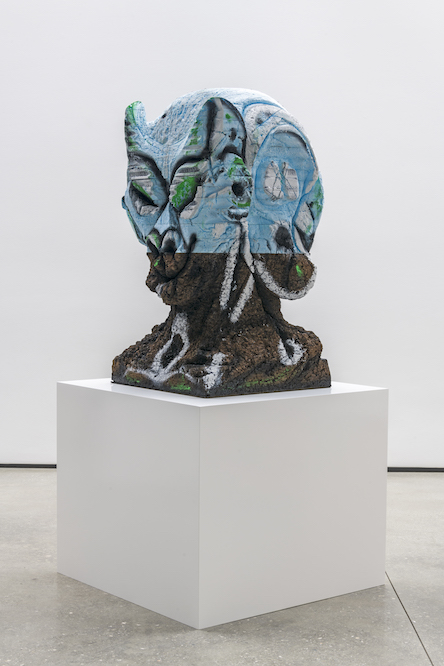
Huma Bhahba, “Four Nights of a Dreamer” (detail), 2018. Image courtesy Institute of Contemporary Art/Boston, 2019. Photo by Charles Mayer Photography.
Bhabha’s purpose seems clear, despite the ambiguities. Her evocation of the extraterrestrial compels a confrontation with what we deem “foreign” on the lands we inhabit. Her sculptures place our biases, sensibilities, neuroses – crystallized, as they are, by history and geopolitics – in stark relief. For this exhibition, Benaam was transposed to a single, austerely-lit gallery, its enormous hands mottled and bruised, preceding a track of clay that suggests, perhaps, a tail. The sculpture is an iteration of earlier works, first begun by the artist in 2002 at a smaller scale; at that time, Bhabha was responding to the American invasion of Afghanistan following 9/11. She made later versions in 2005 and 2006 during increased US military presence in the Middle East (photographs of which hang in an adjoining room). The piece takes on a haunting, funereal tone in the gallery it occupies, its black surface redolent of the scores of body bags carrying dead soldiers which became a daily fixture on newscasts around the world during George W. Bush’s presidency. Evoking the particularities of this history transforms the otherworldliness of Bhabha’s semi-figurative creations – the initial appeal of an encounter with beings outside our own time and space – into something much more generative, and disquieting: we must confront these figures here and now.
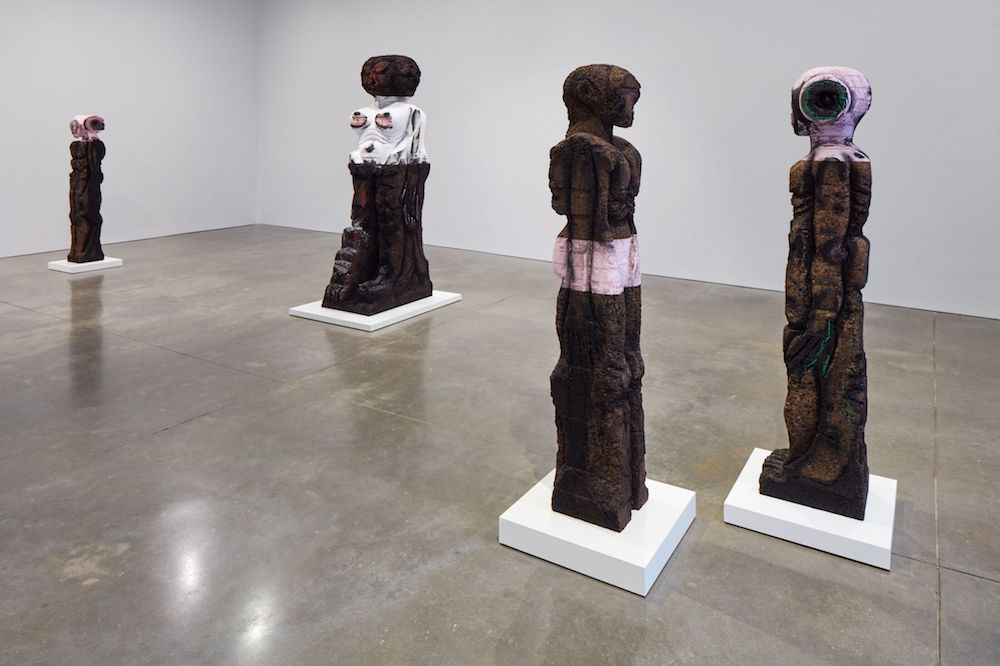
“Huma Bhabha: They Live” (installation view), 2019. Image courtesy Institute of Contemporary Art/Boston, 2019. Photo by Charles Mayer Photography.
Bhabha oscillates between disclosure and concealment. Her keen materiality deploys blown-out tires, clay hand-molded onto ragged chicken wire, worn wood, and Styrofoam. Tupac Amaru (2010) derives its name from the heroic last Indigenous monarch of the Inca Empire who fought against Spanish colonists in the sixteenth century. From the front, a scrawled ribcage, roughly painted eyes, and a mouth on white Styrofoam all rest atop a fiberboard platform. Where we might expect its backside to be, the artist has formed another face from clay, wood, and wire. A curving horn protrudes, giving the sculpture a minatory quality; it beckons and then warns us to back away. Across the gallery, Ghost of Humankindness (2011) seems to confront Tupac Amaru; it too takes its form from stacked, scuffed, and marked Styrofoam and is affixed with a clay and wire visage. Closer inspection revealed that these contemporary effluvia have been dematerialized by an ancient technique. The artist used the lost-wax method to cast the entire sculpture in bronze. Here, Bhabha’s skill in thwarting expectations is inextricable from her meticulous attention to formalism, prompting us to engage more deeply with works that are often less monumental than works like Benaam, but no less meticulously formed.
Confronted with bizarre and unknown faces, we must make sense of the uncanny and the unfamiliar – and in this process of rationalization, we’re taken into our own psychological recesses. A series of masks, whose molded forms are affixed with synthetic hair and plastic tubing emerging from their orifices, recall both the titular entities of Alien Vs. Predator (2004) and the ceremonial Kwakwaka’wakw masks that inform the work of Beau Dick. In My Skull is Too Small (2009), the standout piece in a gallery of grouped figures, Bhabha stages two busts atop a large wooden base marked with graffiti scrawls. Steel extends from the armature of one bust to fluidly suggest a link with the other; the busts, however, do not face each other. As with her standing figurative sculptures, Bhabha is keen to show her hand, placing disparate elements together to animate a larger assemblage. Here, the “faces” direct their gazes in a single direction; there are no Janus-like echoes of Tupac Amaru. Rather, Bhabha’s eerie combination and distancing of the busts forces a juxtaposition that animates the individual visages – each one becomes more distinct, menacing. Consider here a statement by the artist, from an interview with the Met’s Sheena Wagstaff: “When you put a face on something … it suddenly wakes up. It’s alive and gradually becomes dominant. Every time you enter its space, you somehow get caught by it looking back at you. That kind of communication can be very emotionally charged.”
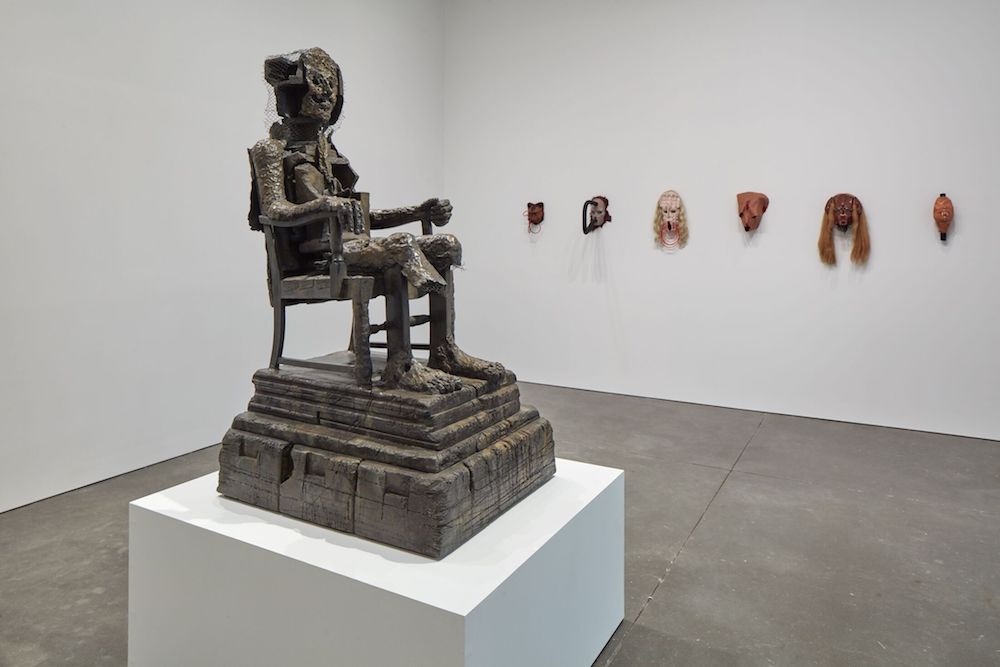
“Huma Bhabha: They Live” (installation view), 2019. Image courtesy Institute of Contemporary Art/Boston, 2019. Photo by Charles Mayer Photography.
Bhabha’s sculptures serve as objective reminders of our ethical responsibility to the Other, locating that responsibility in our face-to-face confrontations with it, what the philosopher Emmanuel Levinas framed as a moral summons. Curator Shanay Jhaveri, in his essay “Acknowledging Pain: Huma Bhabha’s We Come in Peace,” notes that the hidden face of Benaam and the multiple faces of We Come in Peace complicate Levinas’s ethical encounter with the precarious nature of their inhuman, otherworldly bodies. By distancing these figures into the realm of the imagination – stretching time and space toward science fiction, rather than the blasted colonial past – Bhabha pointedly offers a glimpse into the endemic cruelty of imperialism, its fundamental inability to recognize the humanity of the subjects forced under its regime.
In this exhibition, however, the countenances of Bhabha’s sculptures evoked recognition more than precariousness. In one room, a selection of busts was arranged at eye level and accompanied by a group of works on paper on the gallery’s walls, collages whose large, skull-like visages have eye sockets adorned with strains of marijuana, cut from High Times magazine – a dry nod to heightened interior states. One bust, Hunterhaus (2009), comprises wire, cast-iron, aluminum, and clay. Bhabha has referred to these busts as “masks,” because of their direct relationship with the viewer’s vision. In the backside of Hunterhaus is a clay sculpture of an eye, which posits a kind of double-vision through the sculpture’s wire mesh: the viewer is at once able to look through while being looked at. The accompanying wall text connects this gaze to the mask’s “metamorphic relationship between an outer face and inner vision.” But in considering Bhabha’s trajectory as a whole – her dedicated surface manipulations and her political commitments to those subjected to catastrophe, war, and plunder – the bust’s hollowed orifices and heightened testify to the systemic violence that has defined and created the figure of the Other. What will we do when confronted with it?

